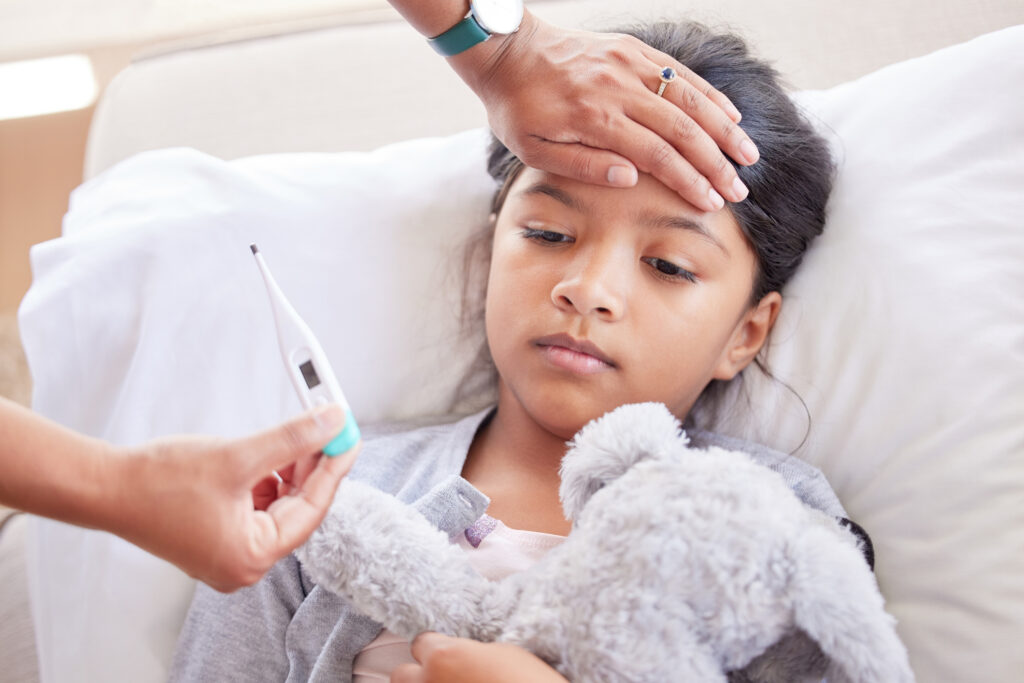WHAT PARENTS NEED TO KNOW ABOUT PNEUMONIA

Pneumonia is not a common illness for children, accounting for just 10-15% of respiratory infections in the winter. But this year there has been an increase in pediatric pneumonia infections which is a bit concerning since we are only in the fall months. The good news is that most children recover from pneumonia with proper treatment. A small number may require hospitalization for oxygen support and IV antibiotics. Those with underlying health conditions are at greater risk of hospitalization and possible death from pneumonia.
What is pneumonia?
Pneumonia is an infection of the lungs that creates inflammation and causes fluid to build up in the air sacs, making it difficult to breathe. The infection can also cause fever and cough with yellow, green or bloody mucus.
What causes pneumonia?
The most common cause of pneumonia is a viral infection. This is especially true for babies and young children who are more susceptible to respiratory syncytial virus (RSV). Other viral causes of pneumonia include influenza, parainfluenza, and adenovirus.
Bacterial pneumonia is typically caused by pneumococcus (streptococcus pneumoniae). Children with this type of pneumonia tend to have a rapid onset of illness and feel very sick. They may have a cough that produces phlegm or mucus as well.
Mycoplasma pneumonia causes a mild form of the infection we call “walking pneumonia.” This is the type of infection that has increased this year, and these infections are more severe than in years past. This could be due to the typical cycle in which we see more mycoplasma every three to five years, or it could be due to the specific bacterial strain that is going around.
Symptoms of Pneumonia in Children
Early symptoms of pneumonia may resemble a common cold or upper respiratory infection. However, watch for these signs that could indicate your child has developed pneumonia:
- Fever lasting more than 3-5 days
- Rapid or labored breathing
- Fatigue or lethargy
- Loss of appetite
- Abdominal pain or vomiting
- Trouble catching their breath
If your child exhibits any of these symptoms, contact your pediatrician immediately.
How is pneumonia diagnosed?
Your CPCMG pediatrician can diagnose pneumonia with a physical exam including a check of your child’s vital signs. Sometimes other tests like a chest x-ray, nasal swab or blood tests are needed to determine if there is a pneumonia or the likely type of pneumonia. Usually, your CPCMG pediatrician will make the diagnosis based on the age of your child, how they are feeling, what the lung exam is like and if performed, what the pneumonia looks like on an x-ray. This helps determine the treatment.
How is pneumonia treated?
Once your CPCMG pediatrician determines what they believe is the cause of your child’s pneumonia, they will make a treatment plan with you. Both bacterial pneumonia and mycoplasma are treated with antibiotics. However, they are treated with different antibiotics so sometimes your doctor will recommend both. Viral pneumonia does not require antibiotics so your doctor will discuss ways to keep your child comfortable while they recover. For more information on treating a cough, click here.
Can pneumonia be prevented?
You can reduce the chances of your child getting pneumonia by keeping your child’s immune system healthy. Read more about seven habits to start practicing today to keep you and your family healthy this winter.
Remember, if you have any concerns about your child’s breathing or their illness in general, please contact their CPCMG pediatrician or call our nurse advice line (call your pediatrician’s office and listen to the prompts to reach a nurse). In case of emergency, call 911.

